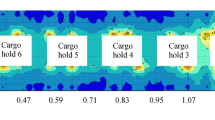Abstract
During design of block joints in ship structures it is assumed that the permissible tolerances for axial and angular misalignment given in shipbuilding standards are not exceeded. This is particularly important for fatigue assessments based on the nominal stress approach which implicitly incorporates stress magnification due to imperfections. Preliminary investigations of thin-plated ship structures (t = 4 mm) showed that (a) it is very difficult to keep the thickness-dependent tolerances for thin plates, and (b) even if the tolerances are kept, the fatigue strength might not be sufficient as the stress magnification incorporated in the nominal stress approach is far exceeded. The present paper highlights the problem in the beginning. The main part describes fatigue tests of components performed in a joint industry project. Stiffened panels were fabricated by different shipyards under realistic shipbuilding constraints. The partly large imperfections (buckles, axial and angular misalignment) were extensively recorded using photogrammetric technique in order to obtain the characteristics of typical pre-deformations. The component tests establishing the link to the fatigue strength were carried out with a stress ratio R = −1 which is typical for naval vessels. Concurrent nonlinear finite element calculations containing the whole test set-up were carried out to obtain relations between pre-deformation and stress increase. After description of the test results, a procedure for the assessment of imperfections is discussed which are measured in the usual way in shipbuilding.
Similar content being viewed by others
References
GL: Rules and Guidelines, I — Ship Technology, Part 1; Seagoing Ships, Chapter 1: Hull Structures. Germanischer Lloyd, Hamburg 2010.
BWB: BV 1040-1 Structural Strength of Surface Ships, German Federal Office of Defense Technology and Procurement (BWB), Koblenz 2007
VSM: Production Standard of the German Shipbuilding Industry. Verband der Deutschen Schiffbauindustrie e.V., Hamburg 2003.
ISO 5817: Welding — Fusion-welded joints in steel, nickel, titanium and their alloys (beamwelding excluded) — Quality levels for imperfections. International Standardisation Organisation, Geneva 2006.
ISO 5817: Welding — Fusion-welded joints in steel, nickel, titanium and their alloys (beamwelding excluded) — Quality levels for imperfections. International Standardisation Organisation, Geneva 2003.
Eurocode 3: Design of steel structures — Part 1–5: Plated structural elements, 2009.
Crocetti R.: On some Fatigue Problems Related to Steel Bridges, PhD-Thesis, Chalmers University of Technology, Gothenburg 2001.
Kuhlmann U. and Günther H.-P.: Web breathing as a fatigue problem in bridge design, Proceedings of the Third International Conference on Thin-Walled Structures, Krakow, 2001.
DVS: Merkblatt 0705 Empfehlungen zur Auswahl von Bewertungsgruppen nach DIN EN 25817 und ISO 5817, Stumpfnähte und Kehlnähte an Stahl, Deutscher Verband für Schweisstechnik, Düsseldorf, 1994.
Hobbacher A.: Recommendations for Fatigue Design of Welded Joints and Components. IIW doc.1823-07, Welding Research Council Bulletin 520, New York 2009.
Imetrics: User Handbook, Imetric SA Technopole, Porrentruy, 2000.
Niemi E., Fricke W. and Maddox S.: Fatigue Analysis of Welded Components — Designer’s Guide to the Hot-Spot Stress Approach. Woodhead Publ., Cambridge 2006.
Author information
Authors and Affiliations
Corresponding author
Rights and permissions
About this article
Cite this article
Eggert, L., Fricke, W. & Paetzold, H. Fatigue Strength Of Thin- Plated Block Joints With Typical Shipbuilding Imperfections. Weld World 56, 119–128 (2012). https://doi.org/10.1007/BF03321402
Published:
Issue Date:
DOI: https://doi.org/10.1007/BF03321402




